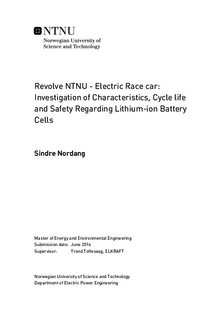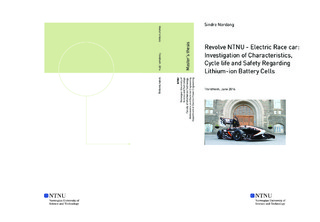| dc.description.abstract | Revolve NTNU is a student organization representing NTNU in the largest student engineering competition in the world, Formula Student. For the 2016 Revolve NTNU project, the team has developed and built the first four-wheel driven electric car in Scandinavia. The car, called Gnist, is designed for an acceleration of 0-100 km/h in 2 seconds and has a weight of less than 180 kg. This master thesis is conducted in cooperation with Revolve NTNU.
In the first stage of the master project, a method for selection of cells to be utilized in the battery package of the race car was developed. The purpose of this method is to obtain an effective battery cell selection procedure for upcoming Revolve NTNU teams. The current stage, involves further investigations of characteristics and safety aspects regarding lithium-ion batteries for a race car application. Emphasis is put on exploring how the battery cells can fully utilize their potential, and how these characteristics can be used as feedback to the race car driver.
Nine different experiments were performed in order to establish the cell s characteristics. The experiments were separated into three groups: Cell tolerance tests, Performance tests and Degradation tests.
Cell tolerance testing revealed that the cell is capable of delivering charging currents of 70A for 300ms, 56A for 1000ms and a maximum amplitude of 80A, i.e. the cell is able to deliver the maximum power requirements of the car s motors. In light of both the Performance and Tolerance testing, entropy was found to have a significant impact regarding heat generation, as charging has a cooling effect on the cell in most of the state of charge range. When removing charge bursts completely, hence lowering the discharge capacity of the test protocol with 60%, the maximum cycle temperature is measured to 55.9C, compared to 58.0C with charging pulses. The declined temperature of only 2.1C at the cost of 60% less discharge capacity implies that removing charge bursts is very disadvantageous in this context.
The Degradation testing showed that surrounding temperature is the most influential factor. When running two similar tests, one at 35C and one at 25C, the one at 25C only degraded to 98.1% capacity after 221.5 normalised cycles while the other had a capacity of 93.1% after 245.3 normalised cycles. Furthermore, it was found that applying charging bursts will improve cycle life. When running the same test protocol with 35C, but with no charging bursts, the capacity was 90.3% after 147.8 normalised cycles.
Through a cell dissection analysis, the production quality of the cells was found to be satisfactory, as no particular deficiencies were found. Through two overcharging experiments, it was found that the maximum temperature exceeded the melting point of aluminium, implying that another material should be utilized in the firewall. Lastly, a redesign of the battery package and chassis is recommended, as the experiments revealed that very high temperatures most likely will hit the car s driver in case of an incident with the battery. | |

